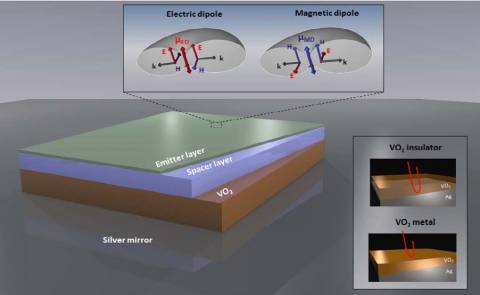Slow emitters transformed into fast light source: direct modulation of spontaneous emission faster than the lifetime limit
Phosphors are extremely efficient light emitters that surround us in our daily lives (light bulbs, LEDs,…) and in scientific labs (lasers, optical fiber amplifiers,…). However their long optical lifetimes prevent them from being turned on and off very quickly, which has essentially prohibited their use in applications where rapid optical modulation is required. Here we use the phase change of VO2 to enable all-optical modulation of erbium ions more than a thousand times faster than their excited-state lifetime. By leveraging the phase-change of a vanadium dioxide (VO2) nanolayer, we demonstrated broadband all-optical direct modulation of 1.5-μm light emission from trivalent erbium ions more than three orders of magnitude faster than their excited-state lifetime.
VO2 is a phase-change material that, when switched by an optical or electrical signal, changes very quickly from a transparent insulating state to a reflective metallic state. In a specifically designed nanophotonic device this change in reflectivity, in turn, switches how nearby erbium ions emit light. As the VO2 changes phase, the erbium emissions go from being generated mostly by magnetic dipole transitions (the rotational torque of magnetic forces), to being generated mostly by electric dipole transitions (the linear push and pull of electric forces). Those two emission pathways have distinct spectra, and the modulation back and forth between the two can be used as a means to encode information.
Distinct from direct `electronic’ modulation of off-chip III-V based lasers or optical modulation using external interferometers, this approach enables both the light emitter and modulator to be monolithically integrated into a single nanoscale device. Besides, both erbium ions and VO2 can be directly deposited on silicon what could be useful for future integrated nanophotonic devices for fast on-chip optical communications.
Légende: Sketch of the nanophotonic device designed and fabricated. Upper inset shows the polarization symmetries of electric dipole and magnetic dipole radiation of Erbium ions. Lower inset illustrates the change in reflectivity when the VO2 layer is in the insulating and metallic phases, respectively.
Références:
1. “Dynamic control of light emission faster than the lifetime limit using VO2 phase-change”,
S. Cueff, D. Li, Y. Zhou, F. J. Wong, J. A. Kurvits, S. Ramanathan, and R. Zia.
Nature communications 6 (2015)
2. http://www.sciencedaily.com/releases/2015/10/151022141724.htm
Collaborations: Prof. Zia, Brown University. Prof. Ramanathan, Harvard University





